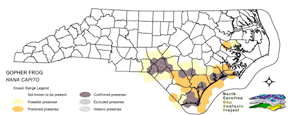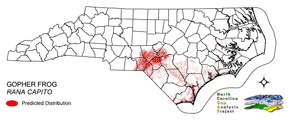
| Taxa: |
| Order: |
| Family: |
| Amphibia |
| Anura |
| Ranidae |
| NatureServe Global Rank: |
| NatureServe State (NC) Rank: |
| G4 |
| S2 |
| Federal Status: |
| NC State Status: |
| FSC |
| --- |


| Land Unit |
| US Fish & Wildlife Service |
| US Forest Service |
| US National Park Service |
| US Department of Defense |
| NC State Parks |
| NC University System |
| NC Wildlife Res. Com. |
| NC Forest Service |
| NC Div. of Coastal Mgmt. |
| Local Governments |
| Non-Governmental Org. |
| Other Public Lands |
| Private Lands |
| GAP Status 1-2 |
| All Protected Lands |
| Statewide |
| Hectares |
| 910.80 |
| 4,157.55 |
| 57,408.03 |
| 16.65 |
| 1,188.54 |
| 562.50 |
| 20,837.34 |
| 3,562.47 |
| 124.29 |
| 188.28 |
| 1,460.07 |
| 61.20 |
| 391,565.43 |
| 5,524.29 |
| 89,846.37 |
| 482,043.15 |
| Acres |
| 2,250.64 |
| 10,273.53 |
| 141,858.30 |
| 41.14 |
| 2,936.95 |
| 1,389.97 |
| 51,490.18 |
| 8,803.05 |
| 307.13 |
| 465.25 |
| 3,607.91 |
| 151.23 |
| 967,579.06 |
| 13,650.82 |
| 222,015.17 |
| 1,191,154.33 |
| % of Dist. on |
| Prot. Lands |
| 1.0 % |
| 4.6 % |
| 63.9 % |
| < 0.1 % |
| 1.3 % |
| 0.6 % |
| 22.5 % |
| 4.0 % |
| 0.1 % |
| 1.6 % |
| 1.6 % |
| < 0.1 % |
| 0.0 % |
| 6.1 % |
| ----- |
| ----- |
| % of Dist. on |
| All Lands |
| 0.2 % |
| 0.9 % |
| 11.9 % |
| < 0.1 % |
| 0.2 % |
| 0.1 % |
| 4.3 % |
| 0.7 % |
| < 0.1 % |
| < 0.1 % |
| 0.3 % |
| < 0.1 % |
| 81.2 % |
| 1.1 % |
| ----- |
| ----- |
|
Found in both open forest and mid-successional stages where shrubs are prevalent. They may favor Carolina bays or cypress ponds in forested areas with emergent herbaceous or woody vegetation (Palis and Jensen 1995). Gopher frogs have also been observed breeding in pond-cypress (TAXODIUM ASCENDENS) dominated depressions (Godley 1992), in small ponds and flooded areas of fields and woodlands (Reay and Mitchell 1999). Will utilize tortoise and small mammal burrows in mesic and dry forests and crayfish burrows in wet sites. Egg masses are laid in water, typically attached to vertical stems of emergent herbaceous, reedy or woody vegetation. NATURE SERVE GLOBAL HABITAT COMMENTS: Primary habitat is native xeric upland habitats, particularly longleaf pine-turkey oak sandhill associations; also xeric to mesic longleaf pine flatwoods, sand pine scrub, xeric oak hammocks, and rudereal successional stages of these habitats; generally occurs only where there are gopher tortoises, but rare or absent at most tortoise colonies; absent from most coastal islands and dunes (Godley 1992). Burrows of gopher tortoise or rodents are used for shelter (Gentry and Smith 1968, Lee 1968, Franz 1986); hides also under logs, under or in stumps, and in sewers (Wright and Wright 1949). Breeding occurs in ephemeral to semi-permanent graminoid-dominated wetlands that lack large predatory fish (Bailey 1991; Moler and Franz 1987; Palis, unpubl. data). Gopher frogs have also been observed breeding in ditches and borrow pits (Means 1986), and have been heard calling from a recently re-filled, normally permanent wetland following an extreme drought (Franz 1991). The reproductive habitat is best described as a circular or near- circular depression marsh, ranging from 0.12 ha to 33.3 ha (Palis and Jensen 1995). Dominant emergent graminaceous vegetation typically includes maidencane (PANICUM HEMITOMON), panic grasses (PANICUM spp.), bluestem (ANDROPOGON sp.), yellow-eyed grasses (XYRIS spp.), pipewort (ERIOCAULON COMPRESSUM), beakrushes (RHYNCHOSPORA spp.), and spikerushes (ELEOCHARIS spp.). Most breeding sites have a small component of woody vegetation such as St. John's-wort (HYPERICUM FASCICULATUM), myrtle-leaved holly (ILEX MYRTIFOLIA), and slash pine that is typically restricted to the edge. Gopher frogs occasionally breed in pond-cypress (TAXODIUM ASCENDENS)- dominated depressions (Godley 1992, Palis pers. obs.). Egg masses are laid within an average of 4.5 cm (range 0-20 cm) of the surface, in water 33-78 cm (mean 59 cm) deep, typically attached to vertical stems of graminaceous emergent vegetation (Palis, unpubl. data), as well as to semi-woody weedy vegetation or small (<8 mm) woody stems (e.g., branches of St John's-wort or myrtle-leaved holly). Egg masses may also be deposited on the bottom in shallow water (Bailey, pers. comm.). |
| Code | Name | Description | NC Natural Heritage Program Equivalent |
| 17 | Maritime Forests and Hammocks | Maritime forests and woodlands dominated by live or sand laurel oak. Estuarine Fringe forests dominated by loblolly pine. | Coastal Fringe Evergreen Forest, Maritime Deciduous Forest, Maritime Deciduous Forest |
| 380 | Coastal Plain Fresh Water Emergent | Emergent vegetation in fresh water seepage bogs, ponds and riverbeds of the coastal plain. Includes alliances dominated by sedges, eelgrass, as well as cane found in unforested cane-brakes. | Small Depression Pond, Sandhill Seep, Floodplain Pool, Unforested Floodplain Canebrake, Riverscour Prairies, Vernal Pools |
| 30 | Cypress-Gum Floodplain Forests | Swamps dominated by black or swamp tupelo with or without Taxodium. Seasonally to semi-permanently flooded hydrology. | Cypress-Gum Swamps |
| 78 | Pond-Cypress - Gum Swamps, Savannas and Lakeshores | Cypress dominated swamps and lakeshores. Can include bays dominated by pond cypress or shorelines of coastal plain lakes with a narrow band of cypress. | Non-riverine Swamp Forest, Natural Lakeshores (in part) |
| 97 | Mesic Longleaf Pine | Longleaf pine woodlands without a major scrub oak component. Slash or loblolly pines may be present as well. | Mesic Pine Flatwoods |
| 42 | Xeric Longleaf Pine | Sandhills including a range of longleaf pine density from predominantly wiregrass, scrub oak dominated to true longleaf pine woodland. This does not include mesic or saturated flatwood types. | Xeric Sandhill Scrub, Pine/Scrub Oak Sandhill, Coastal Fringe Sandhill |
| 46 | Xeric Oak - Pine Forests | Mixed forest dominated by yellow pines with white or northern red oaks co-dominating. | Pine Oak Heath |
| 232 | Xeric Pine-Hardwood Woodlands and Forests | Mixed forest dominated by yellow pines with drier oaks including southern red, post, and chestnut oaks. | Dry Oak Hickory Forest |
| 382 | Dry Mesic Oak Pine Forests | Mixed forests of the coastal plain and piedmont. Includes loblolly pine with white, southern red and/or post oak and loblolly with water oak. On basic sites of the piedmont, eastern red cedar may co-occur with post, black, and blackjack oaks. | Dry Mesic Oak Hickory Forest, Xeric Hard Pan Forest, Chestnut Oak Forest, Dry Mesic Oak Hickory Forest, Dry Oak Hickory Forest |
| 220 | Piedmont Xeric Pine Forests | Dry to xeric pine forests dominated by Virginia pine, shortleaf pine or Eastern Red Cedar. | Pine Oak Heath |
|
Gentry, J. B. and M. H. Smith. 1968. Food habits and burrow associates of PEROMYSCUS POLIONOTUS. J. Mammalogy. 49:562-5.
Lee, D. S. 1968. Herpetofauna associated with central Florida mammals. Herpetologica. 24:83-4. Case, S. M. 1978. Biochemical systematics of members of the genus RANA native to western North America. Syst. Zool. 27:299-311. Altig, R. and R. Lohoefener. 1983. RANA AREOLATA. Cat. Am. Amph. Rep. 324.1-324.4. Franz, R., C. K. Dodd, Jr., and C. Jones. 1988. Life history notes:RANA AREOLATA AESOPUS (Florida gopher frog). SSAR Herpetol. Rev. 19:33. Bailey, M. A. 1991. The dusky gopher frog in Alabama. J. Alabama Acad. Sci. 62(1):28-34. Wright, A. H. and A. A. Wright. 1949. Handbook of frogs and toads of the United States and Canada. Comstock Publishing Company, Ithica, NY. 640 pp. Conant, R. and J. T. Collins. 1991. A field guide to reptiles and amphibians:eastern and central North America. Third edition. Houghton Mifflin Co., Boston, Massachusetts. 450 pp. Palis, J. G., and J. B. Jensen. 1995. Distribution and breeding biology of the flatwoods salamander (Ambystoma cingulatum) and gopher frog (Rana capito) on Eglin Air Force Base, Florida. Final Report. Florida Natural Areas Inventory, Tallahassee, Florida. Godley, J. S. 1992. Gopher frog RANA CAPITO Le Conte. Pages 15-19 in P. E. Moler, editor. Rare and endangered biota of Florida. Vol. III. Amphibians and reptiles. Univ. Press of Florida. Reay, K. K., and J.C. Mitchell. 1999. Atlas of amphibians and reptiles in Virginia (1). Richmond, VA: Virginia Dept. Game and Inl. Fisheries. Semlitsch, R. D., J. W. Gibbons, and T. D. Tuberville. 1995. Timing of reproduction and metamorphosis in the Carolina gopher frog (RANA CAPITO CAPITO) in South Carolina. Journal of Herpetology 29:612-614. Mount, R. H. 1975. The Reptiles and Amphibians of Alabama. Auburn University Agricultural Experiment Station, Auburn, Alabama. vii + 347 pp. Means, D. B. 1986. Threatened:dusky gopher frog. Pp. 30-1 in R. H. Mount (ed.). Vertebrate Animals of Alabama in Need of Special Attention. Alabama Agricul. Exp. Sta. Auburn University, Auburn, AL. Moler, P. E. and R. Franz. 1987. Wildlife Values of Small, Isolated Wetlands in the Southeastern Coastal Plain. Pp. 234-41 in R. R. Odum, K. A. Riddleberger, and J. C. Ozier (eds.). Proceedings of the Third Annual Nongame and Endangered Wildlife Symposium Dundee, H. A., and D. A. Rossman. 1989. The amphibians and reptiles of Louisiana. Louisiana State Univ. Press, Baton Rouge. Franz, R. 1991. Remember the drought? Florida Wildl. 45:10-2. Collins, J. T. 1990. Standard common and current scientific names for North American amphibians and reptiles. SSAR Herpetol. Circular No. 19. 41 pp. |
For more information please contact them at:
NC-GAP Analysis Project
Dept. of Zoology, NCSU
Campus Box 7617
Raleigh, NC 27695-7617
(919) 513-2853
www.basic.ncsu.edu/ncgap